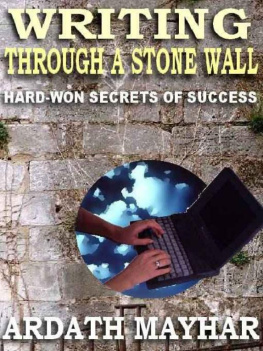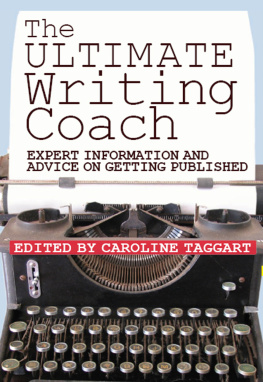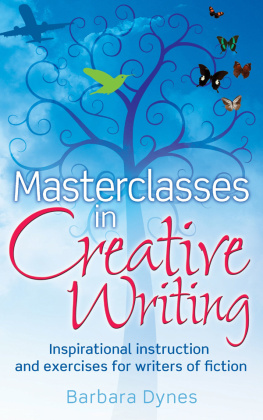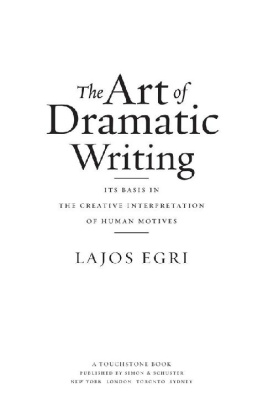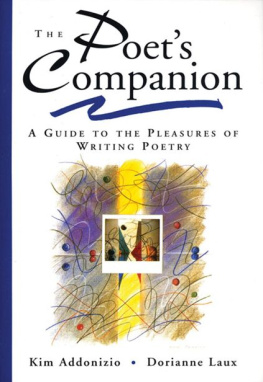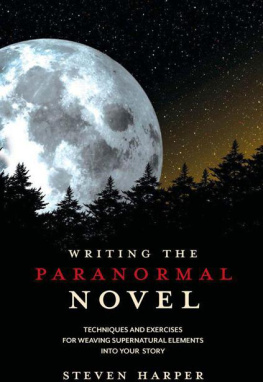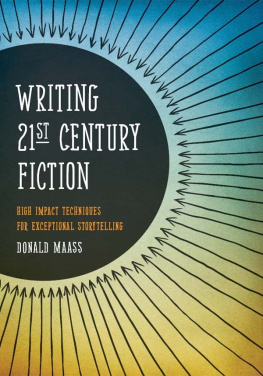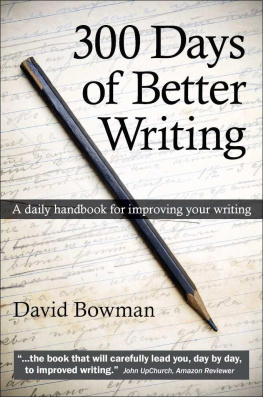Ardath Mayhar - Through a Stone Wall: Lessons from Thirty Years of Writing
Here you can read online Ardath Mayhar - Through a Stone Wall: Lessons from Thirty Years of Writing full text of the book (entire story) in english for free. Download pdf and epub, get meaning, cover and reviews about this ebook. publisher: Renaissance, genre: Art. Description of the work, (preface) as well as reviews are available. Best literature library LitArk.com created for fans of good reading and offers a wide selection of genres:
Romance novel
Science fiction
Adventure
Detective
Science
History
Home and family
Prose
Art
Politics
Computer
Non-fiction
Religion
Business
Children
Humor
Choose a favorite category and find really read worthwhile books. Enjoy immersion in the world of imagination, feel the emotions of the characters or learn something new for yourself, make an fascinating discovery.
- Book:Through a Stone Wall: Lessons from Thirty Years of Writing
- Author:
- Publisher:Renaissance
- Genre:
- Rating:4 / 5
- Favourites:Add to favourites
- Your mark:
- 80
- 1
- 2
- 3
- 4
- 5
Through a Stone Wall: Lessons from Thirty Years of Writing: summary, description and annotation
We offer to read an annotation, description, summary or preface (depends on what the author of the book "Through a Stone Wall: Lessons from Thirty Years of Writing" wrote himself). If you haven't found the necessary information about the book — write in the comments, we will try to find it.
Ardath Mayhar: author's other books
Who wrote Through a Stone Wall: Lessons from Thirty Years of Writing? Find out the surname, the name of the author of the book and a list of all author's works by series.
Through a Stone Wall: Lessons from Thirty Years of Writing — read online for free the complete book (whole text) full work
Below is the text of the book, divided by pages. System saving the place of the last page read, allows you to conveniently read the book "Through a Stone Wall: Lessons from Thirty Years of Writing" online for free, without having to search again every time where you left off. Put a bookmark, and you can go to the page where you finished reading at any time.
Font size:
Interval:
Bookmark:
Renaissance
www.renebooks.com
Copyright 2005 by Ardath Mayhar
NOTICE: This work is copyrighted. It is licensed only for use by the original purchaser. Making copies of this work or distributing it to any unauthorized person by any means, including without limit email, floppy disk, file transfer, paper print out, or any other method constitutes a violation of International copyright law and subjects the violator to severe fines or imprisonment.
This small collection of essays was written over a period of a number of years, in connection with the classes in fiction writing that I have taught from time to time. While they may overlap, to some extent, material to be found in the many books on writing on the shelves, I believe that there is enough hard-won experience reflected here to justify another volume in this field.
You will encounter many pitfalls and stonewalls in the business of writing. Any professional has had numerous experiences that can be of help to those engaged in trying to write for publication. I have tried to put up signs that will help you to write through those stone walls, here and there:
In today's overworked and understaffed publishing world, it is more and more true that the decision to read or not to read a manuscript may depend upon the beginning of the story or nonfiction piece. Editors read huge stacks of manuscript every week, and their eyeball-power is strained to its limits.
It is not, however, only the editor who makes his decision on the basis of two or three pages. The casual reader, browsing through a bookstore, will more often than not decide upon the purchase of a book by reading the first paragraph.
I have done this myself, knowing that some books take a hundred pages to hit their strides. And yet my eyes, too, suffer from overwork, and this is such a convenient shortcut.
As one who has taught people writing, as well as editing the work of beginning and professional writers, I can say with some truth that you usually know at the end of that first paragraph whether the work is going to be worth the time and eyestrain devoted to completing it. By the third page, you can be sure that if there will be any strengths they would have showed up.
But the first page and the first paragraph and the first LINE of the first paragraph can grab you so solidly, in some cases, that you are well and truly caught by the proverbial Narrative Hook. Never discount its value.
This is not a device used by hacks to sell potboilers, believe me. It is a necessary concomitant of writing commercially viable prose, and it is as true for nonfiction writers as it is for those who create fiction.
Many years ago I attended a writer's conference at which one of the prominent agents of the day was a speaker. I will never forget the line that he quoted as hooking him on a story that turned out to be disappointing, yet which he read to the end, simply because of the lead.
"They piled out of the cabin and squared off in the snow. That line has stuck in my mind since 1952, if you can believe that. Look at ithow lean, and yet how full of information it is!
You are in the north country (cabin and snow). At least two people are involved in the action, and there is a fierce altercation in progress, or they wouldn't be serious enough to carry the action out into the snow. In twelve words, a novice writer stumbled upon the perfect way to begin a story that he had not yet learned the skill to complete on the same level.
Another fine example of a lead line that pulls you, willy or nilly, into the story is that of Mary Renault's novel THE LAST OF THE WINE. It is to the effect that when the narrator is depressed about anything, he recalls that on the day I was born my father wanted me killed. This jerks you up short and will not let you go until you learn all the circumstances surrounding this character and his background.
Once you have that perfect first line, you cannot afford to let your fishing line go slack. The paragraph into which it leads should develop that initial statement, creating still more interest, suspense, or atmosphere.
It is a good idea to analyze books and stories that you particularly enjoy. Watch how the writer went about catching your attention. How did he introduce his story? How was the main character introduced? What background is indicated, either directly or by implication, and what effect does it have upon your perception of the action and the people involved?
There are many ways in which to begin a story, and new ones are being invented all the time. Yet every story has its own best beginning, and it is up to you as the writer to learn how to find it, and, indeed, at which point it is best to start telling your tale. Not only will this affect the reception of the story, it will color your own approach to writing it, for that beginning is also your own first immersion in this story you want to tell.
There have been stories that had problems that were solved when the writer went back and created a new lead. I have seen entire books rewritten in first instead of third person, or vice-versa, as a result of restudying that lead. To a great extent, it is even more important than the ending.
Actually, by the time a reader gets to the end of the book, he has usually bought it and can't do anything about it, so a disappointment there creates only a delayed problem. An editor can usually spot a problem with an ending and make excellent suggestions for correcting it. But if your lead paragraph hasn't snagged that editor into buying the book, you will never know.
If your lead paragraph is an inducement to the reader/editor to finish reading your story, then the last few sentences can be your opportunity to make him glad that he did. It is so easy to get lazy near the end of a book or a story.
You have worked very hard, forming good characters and a fascinating plot. You have done a wonderfully dramatic climax. At this point you are just finishing up, it sometimes seems, and your task is done.
But it isn't.
At this point, you need to provide some sort of summation of your story. Have you settled all the important situations? Have you tied off all the subtle threads that spun off from the main plotline? Perhaps all your characters are now prepared to live happily ever after, but something still remains to be done.
You have to make it all make sense. Something needs to convince the reader that all the sturm und drang was worthwhile, that the characters and the reader and even the writer learned something or accomplished something, even if it was only enjoyment.
It is at this point that you make a lasting friend and reader. Here you convince him that you are a writer after his own heart, one who takes infinite pains to make certain that his sense of fitness and completion is satisfied. You have hung in there to the very end, trying hard all the while.
How many stories have you read that left you with a vague sense that you were uncomfortable with their endings, no matter how logical they might seem? Something was simply amiss. You couldn't say just what, but something was.
Next pageFont size:
Interval:
Bookmark:
Similar books «Through a Stone Wall: Lessons from Thirty Years of Writing»
Look at similar books to Through a Stone Wall: Lessons from Thirty Years of Writing. We have selected literature similar in name and meaning in the hope of providing readers with more options to find new, interesting, not yet read works.
Discussion, reviews of the book Through a Stone Wall: Lessons from Thirty Years of Writing and just readers' own opinions. Leave your comments, write what you think about the work, its meaning or the main characters. Specify what exactly you liked and what you didn't like, and why you think so.

